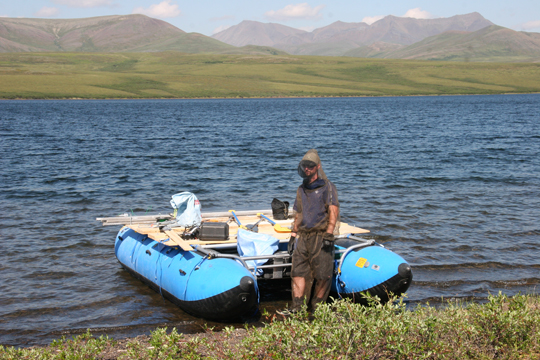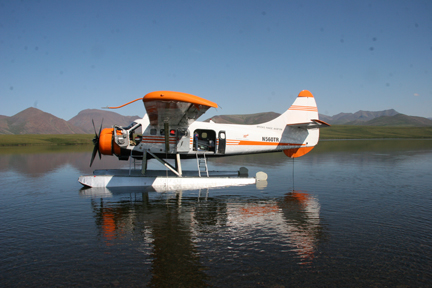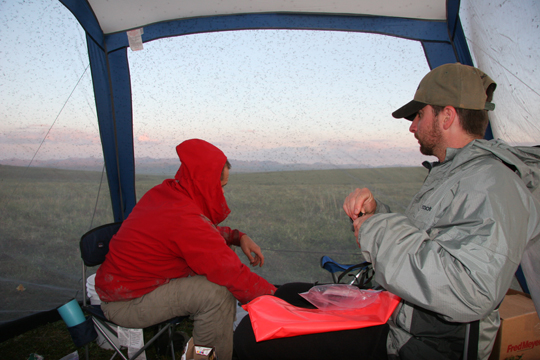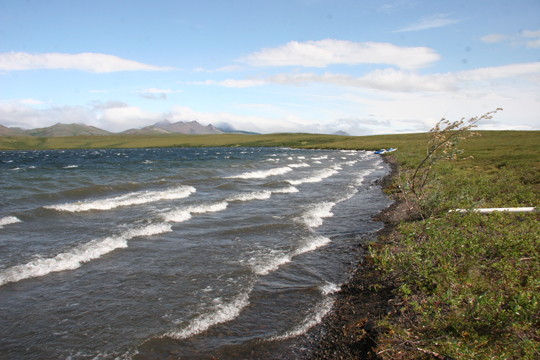 |
||||||||||||||
|
|
||||||||||||||
|
Brooks Range Alaska
|
|
The Holocene Paleomagnetic Record of the Arctic - Collaborators include Joseph Stoner, Matt Finkenbinder, Jason Dorfman, and Bruce Finney among others The goal of this project is to reconstruct the Holocene paleomagnetic record of the Arctic and investigate linkages with regional climate using lake core studies. At present, there are no terrestrial Arctic paleomagnetic data to the west of the historical motion of the North Magnetic Pole nor data of sufficient quality and resolution that extend beyond the last 4000 yrs. To fill this spatial and temporal data gap, new geographical vantage points are targeted, including NW Alaska, NE Alaska. The central focus of this project is to recover continuous 3 to 5 m-long sediment cores from Arctic lakes for a series of analytical techniques including magnetic, lithostratigraphic, geochemical and biological measurements. The majority these sites have been previously cored so it is known that the lakes contain high-quality records spanning the late glacial and Holocene, however the sites must be re-cored because insufficient sediments remain. Burial Lake is know to have a sediment record that extends to ~40 kas. A series of methods will be used to document the climate history of the region including environmental magnetism, geochemistry, scanning XRF, biogenic silica and a host of biological climate proxies. The paleomagnetic and environmental magnetic records will be studied on multiple cores from each lake by alternating field demagnetization of u-channel samples at the Oregon State University Paleomagnetism Laboratory following on prior successful Arctic paleomagnetic studies.
Resulting publications include A 31,000 Year Record of Paleoenvironmental and Lake-Level Change from Harding Lake, Alaska, USA. Physical and geochemical proxy analyses of sediment cores from Harding Lake in central Alaska are used to reconstruct paleoenvironmental change and millennial scale fluctuations in lake level for the last w31,000 years. We analyzed a composite 422 cm core from the lake depocenter (42.1 m water depth) and identified 4 distinct lithologic units based on variability in dry bulk density, organic matter, biogenic silica, carbon to nitrogen mass ratios (C/N), organic matter carbon isotopes (d13C), pollen, and elemental abundances via scanning X-ray fluorescence, with age control provided by 16 Accelerator Mass Spectrometry radiocarbon dates and 210Pb dating. In addition, we analyzed a transect of cores from 7.1 m, 10.75 m, 15.91 m, and 38.05 m water depths to identify lake level fluctuations and to characterize sediment compositional changes as a function of water depth. Organic matter content and magnetic susceptibility values in surface sediments from all transect cores show a strong correlation with water depth. Interpretation of four lithologic units with well-dated contacts produced a record of water-depth variations that is consistent with independent climate records from eastern Beringia. Basal coarse- grained sediments (quartz pebble diamicton) were deposited prior to 30,700 calendar years before present (yr BP), possibly from fluvial reworking or deflation during a period of severe aridity. Unit 1 sediments were deposited between 30,700 and 15,700 yr BP and are characterized by a low organic matter content, a high magnetic susceptibility, and low biogenic silica concentrations resulting from very low lake levels, low terrestrial and in-lake productivity and a high flux of clastic sediment. An abrupt increase in organic matter and biogenic silica concentration marks the transition into Unit 2 sediments, which were deposited between 15,700 and 9,400 yr BP when lake levels were higher and variable (relative to Unit 1). The transition to full interglacial conditions at 9,400 yr BP marks the beginning of Unit 3. Here an abrupt increase in the sedimentation rate, organic matter and biogenic silica concentration occurs (along with a corresponding decrease to low magnetic susceptibility). These high values persist until 8,700 yr BP, signifying a rapid rise to higher lake levels (in comparison to Units 1 and 2). Unit 4 sediments were deposited between 8,700 yr BP to 2010 AD and generally contain high concentrations of organic matter and biogenic silica with low magnetic susceptibility, suggesting that lake levels were relatively high and stable during the middle to late Holocene.
A 40,000-yr Record of Environmental Change from Burial Lake in Northwest Alaska. Burial Lake in northwest Alaska records changes in water level and regional vegetation since _39,000 cal yr BP based on terrestrial macrofossil AMS radiocarbon dates. A sedimentary unconformity is dated between 34,800 and 23,200 cal yr BP. During all or some of this period there was a hiatus in deposition indicating a major drop in lake level and deflation of lacustrine sediments. MIS 3 vegetation was herb-shrub tundra; more xeric graminoid-herb tundra developed after 23,200 cal yr BP. The tundra gradually became more mesic after 17,000 cal yr BP. Expansions of Salix then Betula, at 15,000 and 14,000 cal yr BP, respectively, are coincident with a major rise in lake level marked by increasing fine-grained sediment and higher organic matter content. Several sites in the region display disrupted sedimentation and probable hiatuses during the last glacial maximum (LGM); together regional data indicate an arid interval prior to and during the LGM and continued low moisture levels until _15,000 cal yr BP. AMS 14C dates from Burial Lake are approximately synchronous with AMS 14C dates reported for the Betula expansion at nearby sites and sites across northern Alaska, but 1000-2000 yr younger than bulk-sediment dates.
|
|
|
|
|





